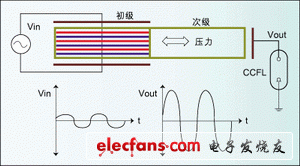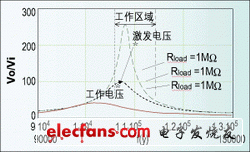In the backlight of portable devices, a buck converter is usually followed by a push-pull inverter (Royer inverter), but its efficiency is low and the number of devices is large. This article discusses a high-efficiency background light power supply solution based on piezoelectric transformers, using UCC3977 (push-pull controller) and piezoelectric transformers EFTU11RoMX50 and EFTU18R0Mx50 to achieve.
Recently, the rapid development of portable devices such as PDAs, Internet handheld devices and notebook computers has further increased the market demand for small-size cold cathode fluorescent lamp (CCFL) background light converters. Usually, a buck converter followed by a push-pull inverter (Royer inverter) is used in these applications, but this method is inefficient in portable applications and because it is essentially a two-stage solution , The number of components used is also relatively large.

Traditionally, the high operating voltage and high excitation voltage required by CCFL are provided by high turns ratio winding type magnetic transformers. The latest advances in piezoelectric transformers (PZT) provide many potential advantages for background light applications, including higher efficiency, smaller size, lower electromagnetic noise, higher available excitation voltage, non-flammable, and sinusoidal operation.
This article discusses a high-efficiency background light power supply solution based on piezoelectric transformers, which uses UCC3977 (push-pull controller) and Panasonic piezoelectric transformers EFTU11RoMX50 and EFTU18R0Mx50.
Background light source
CCFL is usually used as the background light source of the color liquid crystal display (LCD) of notebook computers and portable electronic devices. CCFL is currently the most efficient light source for display backlighting. Since high AC voltage is required to operate CCFL, a high-voltage DC / AC inverter is required. PZT-based inverters can provide sinusoidal output voltage, which is very helpful to reduce RF radiation. RF radiation may interfere with other electronic equipment and may reduce the operating efficiency of the entire system. In addition, the sinusoidal excitation generated by PZT-based inverters can also produce optimal current-to-light conversion efficiency in CCFL. The working voltage of CCFL is much higher than that of other light sources. It usually requires 300 to 800 volts AC (depending on the length of the lamp), but the overall power consumption is very low.

Recently, a very bright white light emitting diode (LED) has appeared. It is a strong competitor of CCFL in LCD display, cell phone and PDA applications. However, when using white LEDs as the backlight of the display, the following issues need to be noted:
a. Almost all LED manufacturers give light intensity in units of new candle light (cd). Usually this value is very high, but it represents the data in the brightest direction. The viewing angle is usually inversely proportional to the brightness of the LCD. Since the total light output of the LCD covers a larger range, in any given direction, the wider the viewing angle, the lower the brightness. A series of LEDs with the same luminous flux output are usually sold in different cross-sections and light intensities. The light intensity may reach 6.4cd at a 20-degree viewing angle, 0.48cd at a 70-degree viewing angle, and may be almost zero at a 160-degree viewing angle. Since lighting consistency is very important for comfort and visual performance, in order to provide consistent lighting on a display, multiple LCDs need to be connected in series or parallel.
b. The life span of these white LEDs is relatively short. After about 1000 hours of operation, they will turn yellow and darken to some extent, which is unacceptable for color displays. Of course, running above the LED rated current will also accelerate this process.
c. Since LEDs are basically current-driven devices, if these LEDs do not share current well, it may cause uneven light distribution in the display. In this case, you can add equalization resistance to each LED, but this will reduce the efficiency of the entire system.
d. Another major drawback is its high cost. Its volume price starts at US $ 2.30 each, which is more expensive than a single CCFL of the same brightness.

When using these as light sources, what you need to consider is what you want to use it for. If you only care about the point brightness of the lamp, then you should consider the peak light intensity; if you need the light diffusion effect, it is very important to choose the appropriate output cross section; when you need to provide illumination for a large display area or the backlight of the LCD display , And when the lamp needs to have a long service life, a small CCFL is the preferred solution.
Transformer for background light converter
The development of magnetic transformers and piezoelectric transformers allows us to construct high-efficiency, small-volume converters. The choice of transformer depends on many factors, including cost, volume and efficiency. For example, compared to a PZT transformer, at a given power level, a magnetic transformer may be thicker, heavier, and less efficient, but it has the advantages of low cost and the ability to work under wider load conditions. PZT transformers have inherent sinusoidal operating characteristics, high excitation voltage, non-flammable and no electromagnetic noise. The comparison of magnetic transformer and piezoelectric transformer is shown in Table 1.

The ceramic piezoelectric transformer was first proposed by CA Rosen in 1956. Unlike magnetic transformers that rely on electromagnetic energy conversion, piezoelectric transformers convert electromotive force into mechanical energy. The conversion of electrical energy to mechanical energy is called the inverse piezoelectric effect, and the conversion of mechanical energy to electrical energy is called the positive piezoelectric effect.
The materials and processes of PZT transformers determine their working characteristics, and each manufacturer has their own "formulation" of materials and structural layers. The common materials used to make PZT are lead zirconate and lead titanate. Single-layer PZTs are low-cost and easy to manufacture but have relatively low voltage gains (typical values ​​are 5 to 10), and may require a step-up magnetic transformer to operate the lamps. The design and manufacture of multilayer PZT is more difficult, but it has a higher voltage gain (20 ~ 70).

Figure 1 shows a typical long-mode PZT for CCFL power supply. The piezoelectric transformer contains some rectangular piezoelectric ceramic layers for energy conversion, and also has a pair of primary electrodes (for input) and a pair of secondary electrodes (for output). The electrical signal input to the primary electrode is piezoelectrically converted into mechanical vibration, and these mechanical vibrations are transmitted to the secondary of the ceramic layer, where the mechanical vibration is piezoelectrically converted into a high-level output. The entire conversion process consumes very little energy.
This inflator has an automatic shutoff,inflate for diferent PVC product, for example,inflate for basketball football,rugbyball,car tire, bike tyre and so on. adapters for different stems, a storage bag, and an LED light with four settings. This Tire Pump is compact, quiet, and easy to use with an USB power cord.It can be a power bank charger for mobile phone.
Portable Air Compressor For Car Tires,Ring Tyre Inflator,Car Tyre Air Pump,Portable Tyre Inflator
SHENZHEN SMARTNEWO TECHNOLOGY CO,. LTD , https://www.newopump.com